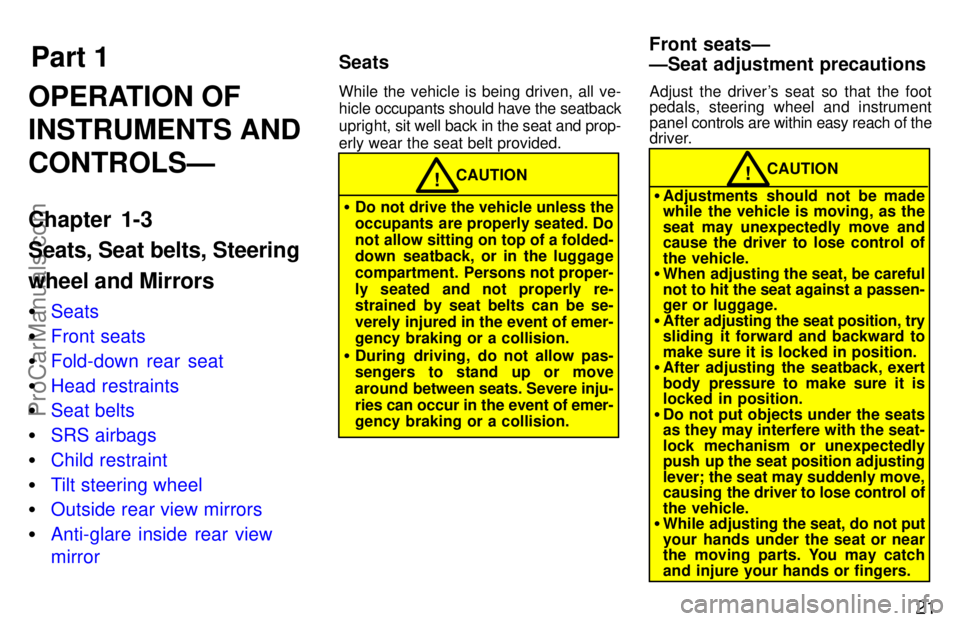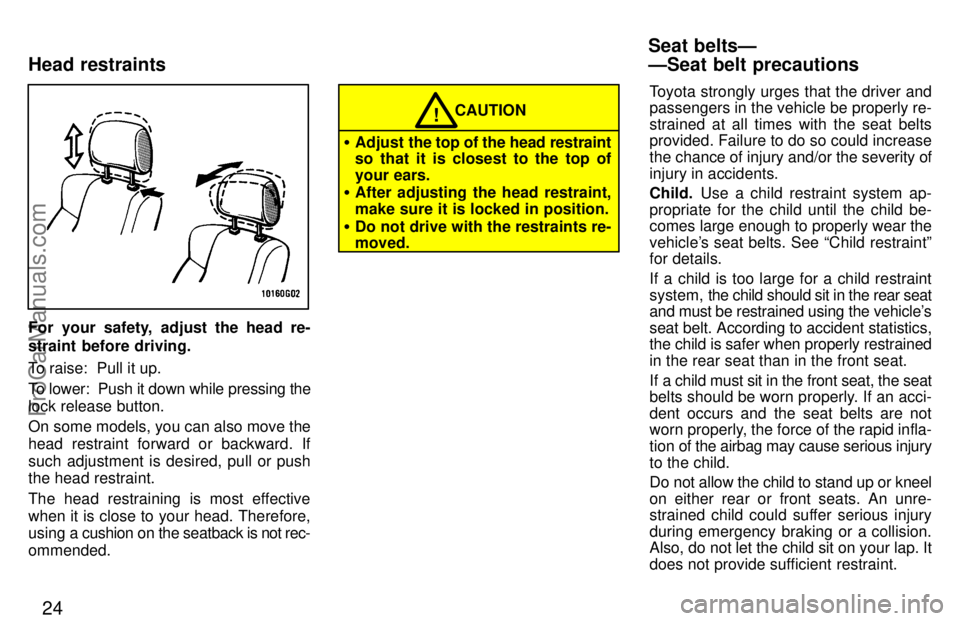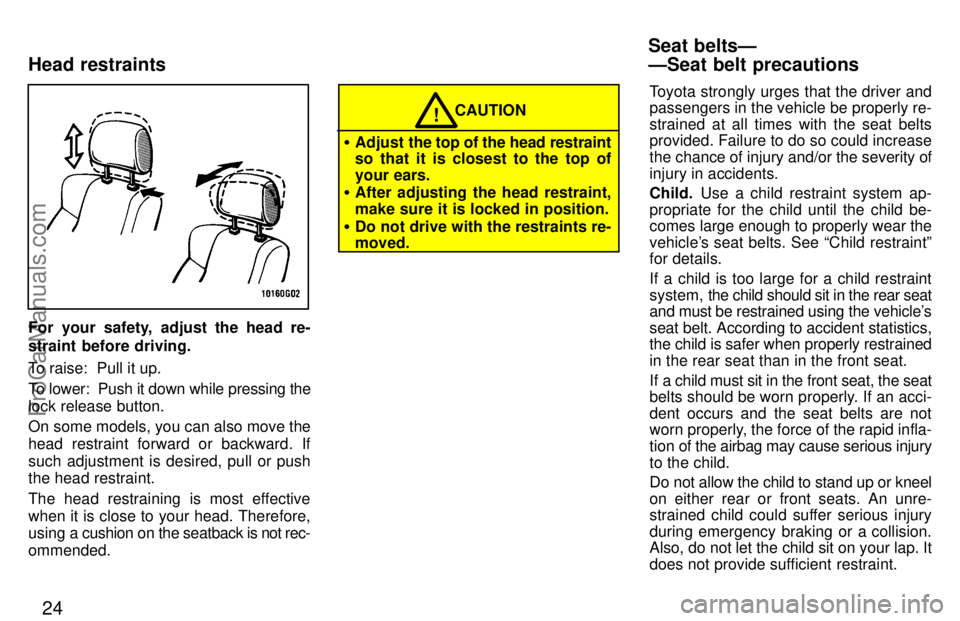Page 25 of 218

Part 1SeatsFront seatsÐ
ÐSeat adjustment precautions
21
OPERATION OF
INSTRUMENTS AND
CONTROLSÐ
Chapter 1-3
Seats, Seat belts, Steering
wheel and Mirrors
�Seats
� Front seats
� Fold-down rear seat
� Head restraints
� Seat belts
� SRS airbags
� Child restraint
� Tilt steering wheel
� Outside rear view mirrors
� Anti-glare inside rear view
mirror
While the vehicle is being driven, all ve-
hicle occupants should have the seatback
upright, sit well back in the seat and prop-
erly wear the seat belt provided.
CAUTION!
� Do not drive the vehicle unless the
occupants are properly seated. Do
not allow sitting on top of a folded-
down seatback, or in the luggage
compartment. Persons not proper-
ly seated and not properly re-
strained by seat belts can be se-
verely injured in the event of emer-
gency braking or a collision.
� During driving, do not allow pas-
sengers to stand up or move
around between seats. Severe inju-
ries can occur in the event of emer-
gency braking or a collision. Adjust the driver's seat so that the foot
pedals, steering wheel and instrument
panel
controls are within easy reach of the
driver.
CAUTION!
� Adjustments should not be made
while the vehicle is moving, as the
seat may unexpectedly move and
cause the driver to lose control of
the vehicle.
� When adjusting the seat, be careful
not to hit the seat against a passen-
ger or luggage.
� After adjusting the seat position, try
sliding it forward and backward to
make sure it is locked in position.
� After adjusting the seatback, exert
body pressure to make sure it is
locked in position.
� Do not put objects under the seats
as they may interfere with the seat-
lock mechanism or unexpectedly
push up the seat position adjusting
lever; the seat may suddenly move,
causing the driver to lose control of
the vehicle.
� While adjusting the seat, do not put
your hands under the seat or near
the moving parts. You may catch
and injure your hands or fingers.
ProCarManuals.com
Page 28 of 218

24
For your safety, adjust the head re-
straint before driving.
To raise: Pull it up.
To lower: Push it down while pressing the
lock release button.
On some models, you can also move the
head restraint forward or backward. If
such adjustment is desired, pull or push
the head restraint.
The head restraining is most effective
when it is close to your head. Therefore,
using a cushion on the seatback is not rec-
ommended.
CAUTION!
� Adjust the top of the head restraint
so that it is closest to the top of
your ears.
� After adjusting the head restraint,
make sure it is locked in position.
� Do not drive with the restraints re-
moved. Toyota strongly urges that the driver and
passengers in the vehicle be properly re-
strained at all times with the seat belts
provided. Failure to do so could increase
the chance of injury and/or the severity of
injury in accidents.
Child.
Use a child restraint system ap-
propriate for the child until the child be-
comes large enough to properly wear the
vehicle's seat belts. See Child restraintº
for details.
If a child is too large for a child restraint
system, the child should sit in the rear seat
and must be restrained using the vehicle's
seat belt. According to accident statistics,
the child is safer when properly restrained
in the rear seat than in the front seat.
If a child must sit in the front seat, the seat
belts should be worn properly. If an acci-
dent occurs and the seat belts are not
worn properly, the force of the rapid infla-
tion of the airbag may cause serious injury
to the child.
Do not allow the child to stand up or kneel
on either rear or front seats. An unre-
strained child could suffer serious injury
during emergency braking or a collision.
Also, do not let the child sit on your lap. It
does not provide sufficient restraint.
Head restraints Seat beltsÐ
ÐSeat belt precautions
ProCarManuals.com
Page 29 of 218

24
For your safety, adjust the head re-
straint before driving.
To raise: Pull it up.
To lower: Push it down while pressing the
lock release button.
On some models, you can also move the
head restraint forward or backward. If
such adjustment is desired, pull or push
the head restraint.
The head restraining is most effective
when it is close to your head. Therefore,
using a cushion on the seatback is not rec-
ommended.
CAUTION!
� Adjust the top of the head restraint
so that it is closest to the top of
your ears.
� After adjusting the head restraint,
make sure it is locked in position.
� Do not drive with the restraints re-
moved. Toyota strongly urges that the driver and
passengers in the vehicle be properly re-
strained at all times with the seat belts
provided. Failure to do so could increase
the chance of injury and/or the severity of
injury in accidents.
Child.
Use a child restraint system ap-
propriate for the child until the child be-
comes large enough to properly wear the
vehicle's seat belts. See Child restraintº
for details.
If a child is too large for a child restraint
system, the child should sit in the rear seat
and must be restrained using the vehicle's
seat belt. According to accident statistics,
the child is safer when properly restrained
in the rear seat than in the front seat.
If a child must sit in the front seat, the seat
belts should be worn properly. If an acci-
dent occurs and the seat belts are not
worn properly, the force of the rapid infla-
tion of the airbag may cause serious injury
to the child.
Do not allow the child to stand up or kneel
on either rear or front seats. An unre-
strained child could suffer serious injury
during emergency braking or a collision.
Also, do not let the child sit on your lap. It
does not provide sufficient restraint.
Head restraints Seat beltsÐ
ÐSeat belt precautions
ProCarManuals.com